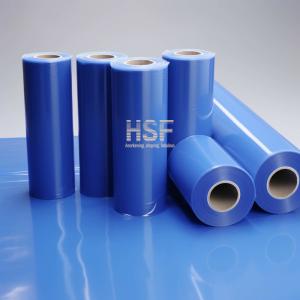
Add to Cart
150 μm blue polyethylene volatile corrosion inhibitor film, for metal packaging, export packaging, maintennance, etc.
The 150-micron blue polyethylene volatile corrosion inhibitor (VCI) film is a specialized type of packaging material designed to protect metal products from corrosion and environmental damage. The film is designed to provide long-term corrosion protection and is suitable for a wide range of metal products. The VCI technology used in this film releases chemicals that create a protective corrosion-inhibiting barrier around the metal surfaces, ensuring that they remain in good condition for an extended period. Here are some of the main applications of 150-micron blue polyethylene VCI film:
1. Heavy machinery and equipment storage:
The VCI film can be used to protect metal parts and machinery during long-term storage, particularly in harsh environmental conditions.
2. Infrastructure components:
The film can be used to protect metal components in infrastructure works such as roads, bridges, and dams from corrosion.
3. Aerospace industry:
The blue polyethylene VCI film is used to protect components and parts of aircraft during storage and transportation.
4. Shipping of metallic products:
VCI film provides an effective barrier against corrosion during shipment, making it a useful solution for exporters and importers of metallic products.
5. Oil and Gas industry:
The VCI film can be used in the oil and gas industry to protect metallic pipes, fittings, and other equipment from corrosion.
Overall, the 150-micron blue polyethylene VCI film is a reliable and effective packaging material designed to protect metal products from corrosion and other environmental damage for a long time. It has numerous practical applications, making it a preferred choice for various manufacturing and storage applications in various industries.
VCI (volatile corrosion inhibitor) film is made of a combination of plastic polymers and corrosion inhibitors. The plastic polymers used in the film can be low-density polyethylene (LDPE), linear low-density polyethylene (LLDPE), or high-density polyethylene (HDPE), among others. These polymers provide strength, flexibility, and durability to the film.
The corrosion inhibitors used in the VCI film are a blend of different chemicals that release vapors or molecules that react with the metal surface and form a protective layer. The type and concentration of the corrosion inhibitors used in the film may vary depending on the specific application and the type of metal being protected.
Some common corrosion inhibitors used in VCI films include:
1. Amines:
These are organic molecules that release vapor or molecules that react with the metal surface and form a protective layer.
2. Nitrites:
These are chemical compounds that release a combination of nitrogen and oxygen ions that neutralize corrosive elements.
3. Phosphates:
These are compounds that react with metal surfaces to form a protective layer, which inhibits corrosion.
4. Benzotriazoles:
These are organic molecules that form a thin protective layer on metal surfaces, inhibiting corrosive ions from interacting with the metal.
The production of VCI films involves several steps. Here's a brief overview of the process:
1. Mixing of Plastic Resins:
The production process usually starts by mixing different plastic resins, such as LDPE, LLDPE, or HDPE, in a large mixing vat. The specific blend of plastic resins used will depend on the desired properties of the finished VCI film.
2. Addition of Corrosion Inhibitors:
Once the plastic resins are mixed, a specific blend of corrosion inhibitors is added to the mixture. The specific blend and concentration of corrosion inhibitors used will depend on the type of metal being protected and the desired level of corrosion protection.
3. Extrusion:
After adding the corrosion inhibitors, the plastic resin mixture is extruded through a die, which forms the VCI film into a continuous sheet or roll. The extrusion process involves heating and melting the plastic resins and corrosion inhibitors to form a homogenous mixture.
4. Cooling:
The extruded VCI film is then cooled, either by air or water cooling, to solidify the plastic resins and corrosion inhibitors into a stable film.
5. Slitting and Winding:
Once the VCI film is cooled and solidified, it is then slit and wound onto rolls of various widths and lengths, depending on the customer's requirements.
The production process of VCI films may involve additional steps or modifications, depending on the specific manufacturer and the desired properties of the finished film. However, the basic steps outlined above are common across most VCI film production processes.
| Property | Test method | Unit | Data | |||
| Thickness | ASTM D6988 | μm | 50 | 100 | 150 | |
| Tensile modulus | MD | ASTM D882 | N/m | 1582 | 3103 | 3200 |
| TD | 1604 | 3117 | 3112 | |||
| Tensile strength @ break | MD | ASTM D882-02 | Kpa | 32.5 | 29.8 | 21.08 |
| TD | 31.8 | 30.1 | 21 | |||
| Elongation @ break | MD | ASTM D882-02 | % | 599 | 752 | 740 |
| TD | 654 | 813 | 810 | |||
| Flexural strength | MD | ASTM D882-02 | Kpa | 14.03 | 8.1 | 5217 |
| TD | 9.6 | 10.5 | 8915 | |||
| Tear strength | MD | ASTM D1922-06a | mN | 3700 | 11092 | 14696 |
| TD | 7661 | 15017 | 19941 | |||
| Dart impact resistance | ASTM D1709-04; A | grams | 321 | 743 | 748 | |

